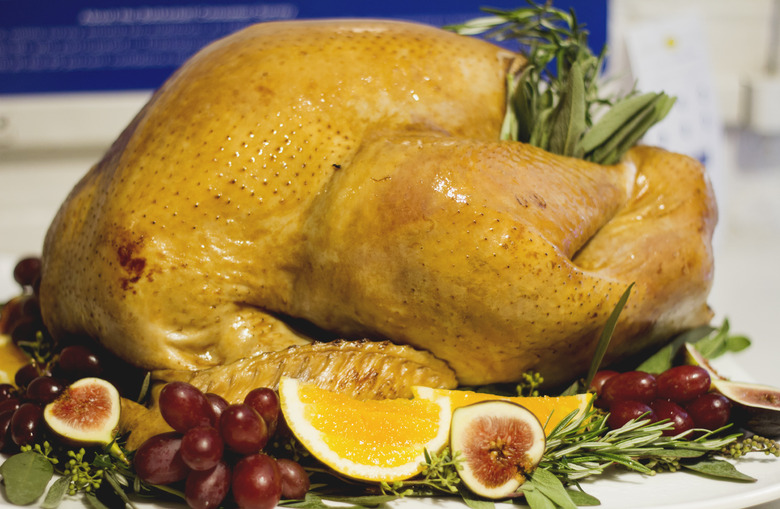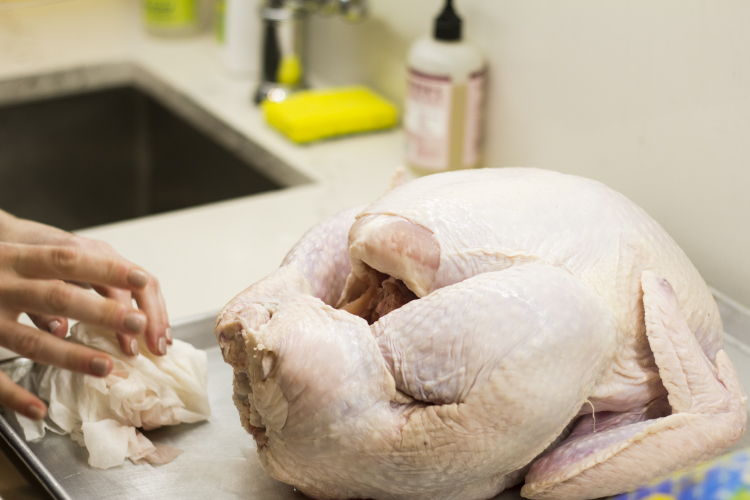I Went To Butterball University, And This Is What I Learned
I've cooked a Thanksgiving turkey twice before, for the holiday in 2015 and 2016, and I was mostly successful. My skin turned out crispy, my breast meat was moist, and I think my thyme butter was a great way to flavor the bird. But my dark meat was a little too... let's say juicy, and I couldn't carve that darn turkey to save my life!
It's safe to say I had a thing or two to learn about cooking a Thanksgiving turkey. So when I had the chance to enroll in a crash course at Butterball University taught by real life helpers from the Butterball Turkey Talk-Line, I was thrilled.
My crash course in Thanksgiving Turkey 101 taught me a few tips and tricks on cooking and presenting the perfect bird, and it would be selfish to keep them to myself! So here are five things you need to know before cooking your bird this year:
How to defrost a turkey
You can't just pop a frozen turkey into the oven, and the Butterball turkey experts said that defrosting questions were among their most frequent inquiries. So how do you defrost a bird? Ideally, it's done in the refrigerator. For every 4 pounds of turkey, your bird needs one day in the fridge, but a defrosted turkey will actually be fine in the fridge for three days before cooking. So Butterball has declared the Thursday before Thanksgiving (which falls on November 16 this year) National Thaw Day. Remove that bird from the freezer, keep it in its wrapper, put it on a sheet pan breast side up, and put the sheet pan on the lowest shelf in your fridge.
But what if you forgot to put your bird in the fridge a week before Turkey Day? You can do a cold water thaw! Once again, leave the turkey in its wrapper, fill up your sink with cold water, and submerge the turkey breast side down. Replace the cold water every 30 minutes to avoid the bird getting above 40 degrees and making everyone at your table sick.
Have you defrosted your turkey and find that the cavity is still a little icy? No worries! Just run cold water through the cavity until the ice melts.
Basting isn't necessarily your friend
Did you ever wonder why the turkey that was supposed to be ready in 3 1/2 hours is taking all day? It may be because you're basting the bird. Every time you open your oven, you lose 25 degrees of heat. Flavor your bird with whatever seasonings you desire before putting it in the oven and keep that stove shut.
Temperature is everything
Turkey can go from a hazardous food source to a dry protein that can't be saved no matter how much delicious gravy you pour on it really quickly. So remember to cook your bird to temperature. That means the breast should be cooked to 165 degrees and the thigh to 180 degrees. Since the thigh needs to come to a higher temperature than the breast, tent the breast with aluminum foil two-thirds of the way through cooking to deflect the heat.
If you've stuffed your bird with stuffing, then the only temperature that truly matters is that stuffing. In order to be safe to eat, it needs to be at least 165 degrees. If it's significantly cooler than the rest of the bird, avoid overcooking your turkey by taking the stuffing out of the turkey, transferring it to a separate pan, and finishing it on its own.
Turkey Carving 101
It's easy to make a mistake when carving a turkey. So what do you do? First, you want to clear everyone else from the kitchen. Carving a turkey is serious business, and doing it at the table or in front of only people will only lead to performance anxiety.
After you ensure you're alone, lift your turkey out of its roasting pan using silicon mitts. If you don't have silicon mitts, insert a wooden spoon into the cavity to lift the bird and hold it using a paper towel. Using a straight knife with a bit of flexibility, cut the thigh and bring it away from the rest of the bird. If it's properly cooked, this should be done easily. Separate the leg from the thigh and put the entire leg on your turkey platter (for the cavemen in your family). Then cut the thigh along the bone. Don't worry about making the dark meat pretty! Then, remove the breast from the bone, getting as close to the carcass as possible. To avoid shredding your meat, cut across the grain. Save the wing meat and the carcass for turkey stock and turkey soup the next day!
How to make an Instagrammable bird
When serving your carved turkey on a platter, don't worry about the presentation. It's OK for it to have flaws! But how do you get a turkey as stunning as this one?
For a shiny, golden skin, brush your turkey with vegetable oil before popping it in to the oven. Butter and olive oil have lower burning temperatures, so they're more likely to give you an uneven coating and dark spots. Before taking your turkey away to carve it, prep a platter with whatever you happen to have in the kitchen! Fresh herbs, figs, seasonal grapes, and various lettuces can all make for a stunning presentation. Kale in particular is sturdy enough to withstand the heat of a turkey and makes for a festive platter. Just be sure to start with a white platter for clean presentation, and you're good to go. No matter which way you cook your turkey, Thanksgiving is a rustic holiday, so you don't need to make your platter minimalist and modern to make it look stunning.
Carolyn Menyes is the entertain and holidays editor at The Daily Meal. Her favorite Thanksgiving tradition is watching people bowl frozen turkeys at canned goods on Fox 8 News in Cleveland. Follow her on Instagram and Twitter.

